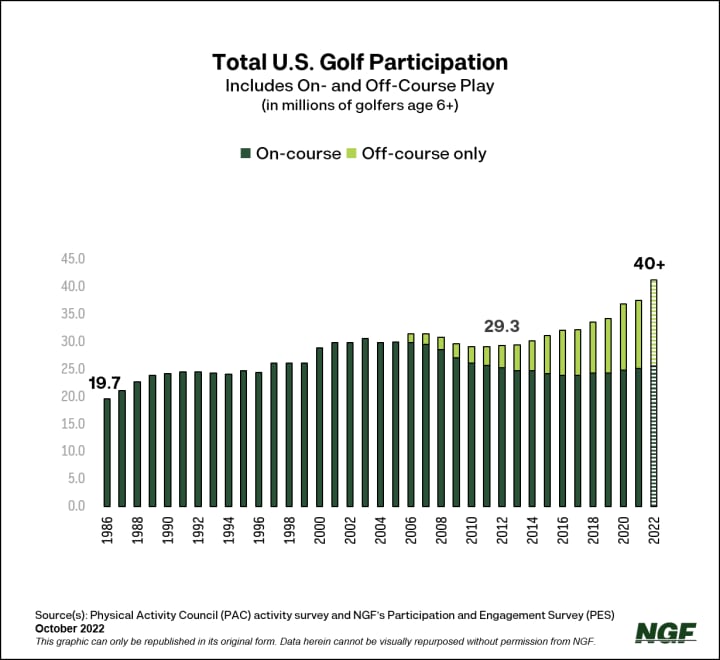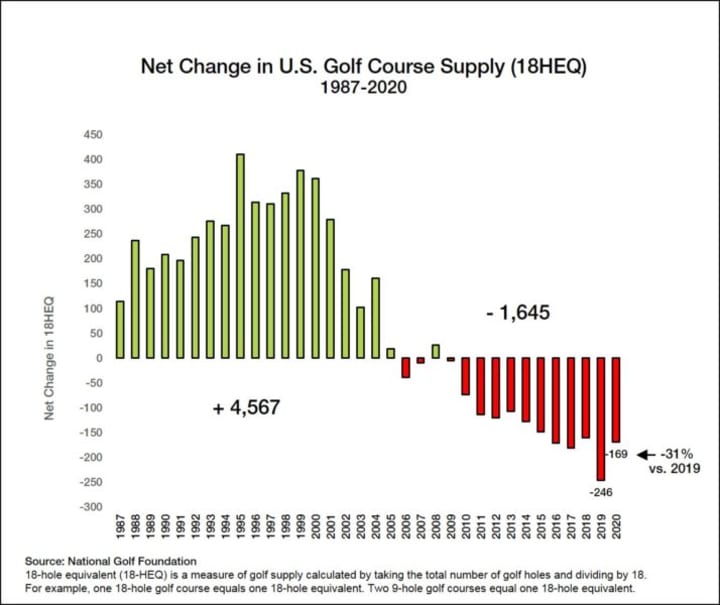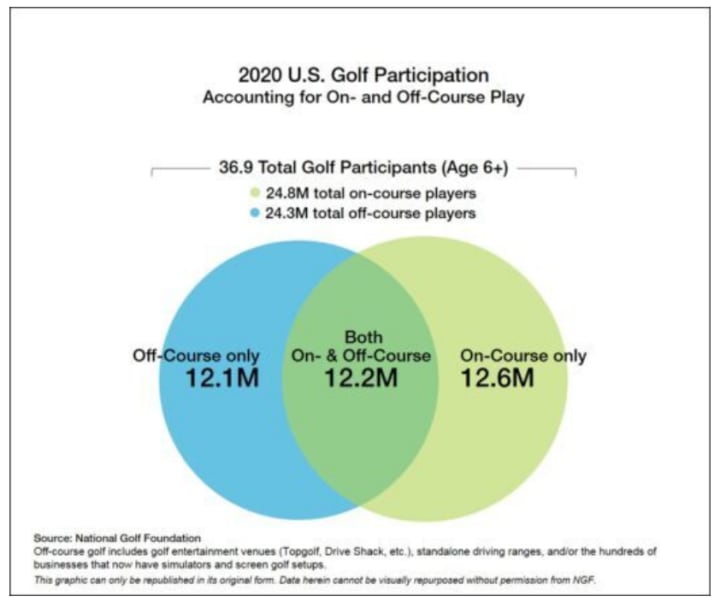Course Correction: The Promising Outlook for the Games of Golf Going Forward
The National Golf Foundation just released its annual report on participation in the sport, finding record numbers of Americans “playing” golf - but in new and different ways. Here’s what the quite surprising findings mean for golfers, golf courses, new and existing golf ventures, sports media and more.

Introduction
Every once in a while, you run across a statistic that simply makes you go “WOW!” As a strategic management consultant and professor, I could think of many more “fancy” ways to label the recent statistics released by the National Golf Foundation (NGF) on the rapid growth - and changing nature of - of golf participation rates in the United States, but “wow!” captures this better than any fancy, academic term to be found anywhere in the voluminous research out there on consumer behavior, business strategy, marketing research, sports management, etc. In short, the game of golf is rapidly changing. And this will have profound implications for everyone - players, companies, media and more - involved in the sport. Additionally, the NGF’s findings create profound opportunities for entrepreneurially-minded folks not just in the United States, but worldwide, to take advantage of the profound - and likely permanent - shift in the way golf is played, spent on, watched, experienced, etc., both right now and into the future.

Golf Participation in America is at Record Numbers - and Fast Changing!
OK, here’s the numbers. The National Golf Foundation recently released its annual report (New Milestones in Golf’s Evolution) on golf participation in the U.S. As you can see in Figure 1 (Total U.S. Golf Participation, 1986-2022) below, 2022 has seen the number of Americans playing golf reach a record high of approximately 40 million!
Figure 1: Total U.S. Golf Participation, 1986-2022

Source: National Golf Foundation, New Milestones in Golf’s Evolution, October 26, 2022 (used with permission)
Now as you can readily see in the above graphic from the NGF - the rising total number of American golfers belies the gloomy projections that have abounded for years on the looming demise of golf. “Experts” (yeah, many a sports or sports business writer, or a consultant and/or professor like myself) have pointed to what is very objective evidence that is indeed out there in abundance which shows that “traditional” golf is indeed struggling - as it, let there be no doubt, is still presently! In fact, according to another report from the National Golf Foundation, as can be seen in Figure 2 (Net Change in U.S. Golf Course Supply, 1987-2020) below, what was a rapid rise in the number of golf courses being built throughout the 1990’s and early 2000’s - which the NGF analysis attributed to a number of economic and real estate factors (after all, who wouldn’t want to live on a golf course?) and yes, the “Tiger Woods factor” as well, the tide has markedly turned in terms of the overall number of golf courses in the United States, with more courses closing than opening for most of the past decade and a half (with the lone exception being 2008 - just before the “housing bubble” burst!). In fact, the reason the NGF report was issued was to celebrate that the trend in golf course closures simply slowed down year-over-year in the most recent data available (2020), in which still 169 traditional, 18 hole courses closed that year!
Figure 2: Net Change in U.S. Golf Course Supply, 1987-2020

Source: National Golf Foundation, National Golf Foundation Reports Big Drop in Golf Course Closures, March 17, 2021 (used with permission)
* Note: The NGF methodology counts both 18 hole courses and 9 hole course, with 2 of the latter counting as a single 18 hole course.
And yet, the data on the growing number of “golfers” in the United States is indeed amazing! This is the fact that, in the aggregate, the total number of American “golfers” has more than doubled since 1986 and grown by more than one-third in just the past decade - with there being ten million more “golfers” in 2022 than there were in 2012! Now, you may have noticed that I put quotation marks around the term “golfers,” and this is very deliberate! This is because - as the National Golf Foundation’s own analysts readily admit, the nature of golf - and golfers - is rapidly changing! Gone are the days when what we would think of as the typical “golfer,” who played a traditional round of golf on an 18 hole, regulation golf course! Today, for the first time, according to the NGF researchers, more Americans are indeed “golfers,” but the majority of the “golfers” are not playing on a real golf course! Indeed, their own analysis of the numbers shows that more “golfers” today are either exclusively - or at least partially - playing golf outside of what we have accepted as being “golf” at all until very recently. The National Golf Foundation researchers concluded their 2021 report by stating that:
“Golf’s evolution has been under way for some years now, and the latest milestones are significant. For the first time in history, the overall participant base – the combination of on- and off-course golfers – will top 40 million Americans in 2022. And in another first, the number of people who play non-traditional, off-course forms of the game in the U.S. will surpass the green-grass total.”
Clearly, what is driving the growth in the total number of people “playing golf” is what the NGF terms to be “off-course golfers,” which they define as golfers who play “newer off-course styles of golf like Topgolf and other golf entertainment, simulator golf, and even virtual-reality (VR) play.”
Analysis
Talk about a statistical and paradigm shift! In all my years of experience as a strategic management consultant and professor, I can think of really no other industry that is - either in the recent past or even today - undergoing perhaps as rapid a change as the “golf industry” is today! Think about the very notion that even the preeminent trade association for the gold industry has expanded its definition of who is a “golfer” to include not just those who play the game on a traditional golf course, but those who play the game in new and different ways - even without a golf club (as is the case with VR golf games!).
Consider one more set of statistics from the National Golf Foundation, shown in Figure 3 (2020 U.S. Golf Participation - Accounting for On- and Off-Course Play) below. According to their 2020 golf participation breakdown (and yes, in that year, as the COVID-19 pandemic radically changed people’s behavior, traditional golf on a traditional golf course quickly became a desired activity [with a sharp uptick in the number of rounds played] as people could safely be together while being socially distant playing golf), the number of people who played golf on a golf course, in a different, non-traditional venue, and those who played both forms of “golf” were all approximately equal - at just over 12 million! This, ladies and gentlemen, is nothing less than a radical shift from the way your fathers - and yes, your mothers - played the game of golf in the past (even in the recent past!).
Figure 3: 2020 U.S. Golf Participation - Accounting for On- and Off-Course Play

Source Data: National Golf Foundation, Used in GolfPass’s Topgolf Continues Growth with a Twist, February 17, 2022 (used with permission)
So what does all of this mean for golfers and for the “golf industrial complex?” And how can entrepreneurial types - both in startups and in big companies - out there “seize the day” and capitalize on the changing nature of golf? Let’s conclude then by taking a peek around the corner of time and look at how this will impact the game of golf - or more accurately, the games of golf - in the near future. Now each of these topics is certainly worthy of a full-fledged analysis on its own, but here, we will briefly outline the major changes we will likely see emerge over the next decade as golf undergoes a huge transformation in the ways that it is played, it is marketed, and it is viewed. Finally, we will look at where golf will likely be in the culture of America - and beyond - as the game - or more accurately, the games of golf - are, I strongly believe, set for a very real expansion in the near future.

“Playing Golf”
What I see in the crystal golf ball is that more and more people will indeed play golf in alternative ways, while traditional golf will continue a slow decline, absent radical changes!
We will see Topgolf, Driveshack and other golf-based entertainment venues grow. Certainly, those two leading names in the marketspace will likely continue to dominate the field - and the revenue - in this area. As you can see in Figure 4 (Topgolf Franchise Growth Projections through 2025) below, Topgolf has seen explosive growth in the U.S., and it has global growth plans that will only accelerate with a change in ownership (more on that in a minute). However, there are also opportunities for further expansion and experimentation along this line of “golftainment,” even on much smaller scales. Golf simulator-focused bars and restaurants are already emerging on a small scale, and are poised for growth (with far, far less capital needed than for a Topgolf or a Driveshack!). And why not, in an era where we are seeing ax-throwing bars and restaurants springing up in seemingly every town in America and where pickleball-based entertainment venues are now proliferating, the combination of activity and yes, beer and wings - and more food and beverages as well seems to be a winning - and profitable - one across the board. The challenge will be to develop new and innovative business models in this space, and those who do, whether on a small or large scale, could well ride this surge of popularity both in playing golf - just not on a golf course - and in the trend towards combining activities with food, with alcohol, and yes, with socializing. Certainly, not just golf simulators, but golf games in virtual reality will be a part of the mix. This is because both simulators and VR enable golf to be played much more quickly, in much smaller places, and in ways that enable more people to engage in a golf-based game together, while also buying food and beverages, too, than either traditional golf or the Topgolf, capital and land-intensive model.
Figure 4: Topgolf Franchise Growth Projections through 2025

Source: Hayden Barnes, Topgolf Economics, 2020 (used with permission)
As for traditional golf courses, the future is, dare I say, not promising. With rising real estate costs, more and more golf courses will likely be converted to higher yielding commercial and residential purposes. That is just simple economics, especially given the fact that costs for labor and everything else that goes into running and maintaining a quality golf course and/or club will only likely rise - and maybe even accelerate - in the coming years, even as golf course revenue will likely continue to be challenged due to aging, and shrinking, pool of “traditional” golfers. Of course, the hope would be that there would be more crossover between Topgolf players and VR golf games to “try” to play traditional golf. As we saw, there is that third of golfers who play both on- and off-course golf presently. The very real question is whether that percentage will grow, will stay approximately level, or even perhaps decline in the future. It will no doubt be critical for the survival of traditional golf to try and draw in new players to try and convert those who are casual - or even more serious - players of off-course golf onto the course. Already, we have seen courses, not just in the U.S., but indeed, around the world, work to actively court the growing number of golfers who look to play a “short loop” - a round of 9, not 18, holes. Also, golf courses, especially of the par 3, short course variety, are increasingly investing in lighted, night golf, enabling them to draw in more golfers - and new and casual players especially - who can play at night. Efforts such as these - and even perhaps direct partnerships with golftainment venues to draw crossover players to play on-course golf - will be absolutely crucial to the survival of traditional golf courses and clubs in the next decade.

Marketing Golf
The way golf is marketed, most notably golf equipment, has to change in light of the way people are playing more golf, just not necessarily on a golf course! It should be noted that the Callaway - yes, the maker of golf clubs and golf-apparel - bought Topgolf in 2021, and earlier this year, changed its name - and the headline does say it all - “Callaway Golf Changing Name to Topgolf Callaway Brands, Highlighting ‘Modern Golf’ Strategy.” With the movement towards more and more people playing off-course golf, the challenge will be how mainline golf companies - especially golf equipment makers - will be able to survive into the future (unless you were to happen to buy the next Topgolf!).
Plain and simple: If the growth in the overall golf market is towards “modern golf” (i.e. golf not played on traditional golf courses), then the traditional golf market for golf equipment - including golf clubs, golf balls, golf accessories, and yes, even golf apparel and footwear, will be a market that will decline almost in-tandem with that of traditional, on-course golf. Now certainly, golf equipment makers and even golf apparel companies can find new ways to market to the growing off-course golf market, but this will take a great deal of innovation and experimentation. The simple fact of the matter that one of the appealing parts for people to play golf, not on a golf course, but at a Topgolf, in a golf simulator, or even in virtual reality, is that you don’t need to make the often quite significant investment in golf equipment and even apparel to do so! The notion of marketing entire sets of clubs - and drivers costing as much as a really big, nice TV - or more - will have to markedly change as the demographics of golf expands, but changes, into the future.

Watching Golf
For the PGA Tour, for ESPN and The Golf Channel (owned by Comcast), and for all the other media driven by traditional professional golf content, there will - no doubt - be challenging days ahead. As the fortunes of traditional golf playing are diminishing, so too would it seem that the money to be made from pro golf - at least as it has been conceived of up until now - may be in serious jeopardy.
Already, we have seen the upstart LIV Tour bring a fresh approach, albeit with controversy and clamor, to the world of professional golf. Whether the venture is ultimately successful or not and stays around, it has certainly prompted intense competition between the new, upstart LIV Tour and the PGA Tour. Still, the even bigger question is that here on the cusp of 2023, will people watch traditional golf on TV - both now and into the future, as we see perhaps a further diminishment of interest in playing on-course golf in general. Will advertisers, sponsors, and yes, fans, continue to support professional tour golf as they have in the past? That is certainly a multi-multi-billion dollar question at the moment.
Could we instead see the development of alternative golf content, centered around the off-course golf that is being played by more and more people - in the U.S. and abroad? Yes, I’d bet that not only will “Professional Topgolf” happen sooner rather than later, but there will likely be other forms of off-course golf that will be the subject of professional leagues - and that will become part of our sports media landscape - in the very near future. Indeed, we could well see the rise of professional VR golfers and e-sports focused on playing golf video games. And yes, two of the biggest names from the world of traditional golf, Tiger Woods and Rory McIlroy, have announced the formation of the TGL Golf League, that will combine technology with golf in a new, made-for-television live golf production to start in January 2024 that Tiger himself calls "the next evolution within professional golf."

All of this fits well with one inescapable fact: In an age of endless television entertainment options, with not just 500 channels, but literally everything ever made in the way of television shows and movies being available somewhere instantly to us today, there is really only one form of live of programming that draws viewers to their screens today. And yes, when much of our television is still based on the “Linear TV” model in a world where TV viewers are increasingly voting with their remotes for the countless “on-demand” options out there today, that is live sports coverage! So yes, why not “Pro Topgolf” - and more new kinds of golf events and leagues? In a world where viewer and advertisers are drawn to live sports and there is consumer thirst for watching both on-demand sports, especially perhaps ones that may be niche today, but mainstream tomorrow (yes, cruise through ESPN+ and see the whole catalog of pro cornhole and yes, ax-throwing competitions you can watch 24/7/365 on demand!), entrepreneurial types can find ways to bring to market new forms of professional “off-course” golf events to both in-person attendees and yes, even more importantly, to our television screens.
And finally, here’s “Exhibit A” that there is a growing consensus that golf on television will not be just of the traditional golf tournaments and the occasional long drive or skills competition. Who is one of the major partners in the new golf venture being formed by Tiger Woods and Rory McIlroy? Well, according to no less than the Sports Business Journal, it is the PGA Tour! The adage “follow the money” comes to mind as “old golf” sees the future in “modern golf!”

The Idea of Golf
Finally, while some (well, much) of this article has seemed like doom and gloom for the game of golf, I don’t want the reader to come away thinking that golf is dead - or even dying. Traditional golf - and golf companies, leagues, and media - do have serious strategic problems. However, the bigger notion of “golf” is on the rise. Millions more Americans pickup a golf club for the first time each and every year, simply because of the ready availability of outlets like Topgolf, golf simulators, and virtual reality golf! And this is multiplied many times when you look at things on a global level as more and more people are drawn to “off-course” golf. So, there has been - and likely will continue to be - significant growth in the total number of “golfers” - domestically and globally, just more and more of them are not and will not likely be golfers in the traditional, “on-course” mold. This presents not as much of an existential threat to the existence of golf and the golf industry, but an opportunity to change and to grow, as we have seen with the rise of Topgolf and Callaway’s purchase of it (and their name change) and with the PGA Tour’s recent investment in non-traditional golf. Yes, the decade ahead will likely be a rough one for those entities focused on on-course golf and the golf courses themselves, unless they find new ways - like some have with 9-hole rounds and lighted golf - to grow their customer base by encouraging more crossover between the off-course golfers and on-course golf.
Yes, the stakes are huge, but many new lines of business and forms of golf entertainment can - and likely will - come to the fore - and thrive - as interest in the games of golf only grows and permeates the culture more and more. And as golf becomes less a game of the elites and more a game for the masses, as golf becomes something that you don’t have to take a day to play, as golf becomes more of an activity for socializing than a game necessarily of skill, and as golf becomes something you do while eating wings or nachos and drinking a beer of a glass of wine, the games of golf may well be the future of golf - a reconceived, reinvented, and yes, perhaps reinvigorated if less challenging “sport” for more and more people globally!
++++++++++++++++++++++++++++++++++++++++++++++++++++
About David Wyld
David Wyld is a Professor of Strategic Management at Southeastern Louisiana University in Hammond, Louisiana. He is a management consultant, researcher/writer, publisher, executive educator, and experienced expert witness. You can view all of his work at https://authory.com/DavidWyld.
Social Media Links to David Wyld:
About the Creator
David Wyld
Professor, Consultant, Doer. Founder/Publisher of The IDEA Publishing (http://www.theideapublishing.com/) & Modern Business Press (http://www.modernbusinesspress.com)






Comments
There are no comments for this story
Be the first to respond and start the conversation.